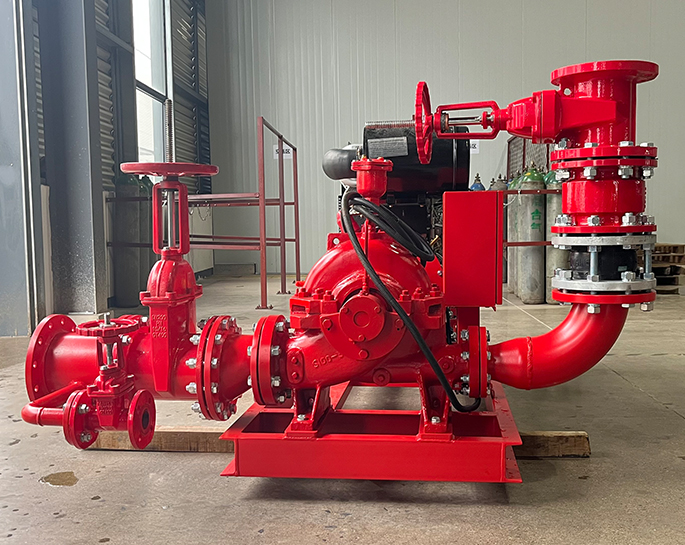How are fire pumps maintained in facilities with dusty or corrosive atmospheres?
Dec 27, 2023
Share:
Maintaining fire pumps in facilities with dusty or corrosive atmospheres is crucial to ensure their proper functioning during emergencies. Here are some general guidelines for the maintenance of fire pumps in such environments:
1. **Regular Inspections:**
- Conduct frequent visual inspections to check for dust accumulation, corrosion, and any signs of damage on the pump and its components.
- Inspect the pump room for cleanliness and ensure that it is free from excessive dust and corrosive materials.
2. **Dust Control:**
- Implement measures to control dust in the pump room. This may include regular cleaning, using dust filters, and employing ventilation systems to reduce airborne particles.
- Consider installing air filtration systems to prevent dust from entering the pump room.
3. **Corrosion Protection:**
- Use corrosion-resistant materials for pump components, especially those exposed to corrosive atmospheres.
- Apply protective coatings or paints to surfaces prone to corrosion.
- Regularly inspect and replace sacrificial anodes or other corrosion protection devices.
4. **Seal Protection:**
- Ensure that seals and gaskets are in good condition to prevent dust and corrosive elements from entering the pump housing.
- Lubricate seals as recommended by the manufacturer.
5. **Cleaning and Lubrication:**
- Regularly clean the pump and its components to remove dust and corrosive residues.
- Follow the manufacturer's guidelines for lubrication, using suitable lubricants that are resistant to the specific conditions of the environment.
6. **Testing and Exercising:**
- Conduct regular testing and exercising of the fire pump to ensure it operates correctly.
- Consider more frequent testing in environments with higher levels of dust or corrosive elements.
7. **Training and Awareness:**
- Train personnel on the specific challenges posed by dusty or corrosive atmospheres.
- Ensure that staff members are aware of the importance of maintaining the fire pump and the associated equipment in such conditions.
8. **Emergency Response Plan:**
- Develop and maintain an emergency response plan that includes procedures for dealing with pump malfunctions or failures.
- Conduct regular drills to test the effectiveness of the emergency response plan.
9. **Documentation:**
- Keep detailed records of maintenance activities, inspections, and tests.
- Document any issues found during inspections and the corrective actions taken.
10. **Professional Maintenance:**
- Engage qualified professionals for routine maintenance and inspections.
- Schedule preventive maintenance based on manufacturer recommendations and industry standards.
By following these guidelines and adapting them to the specific conditions of the facility, you can help ensure the reliability and effectiveness of fire pumps in dusty or corrosive atmospheres. Always refer to the manufacturer's recommendations for maintenance and consult with qualified experts when needed.

1. **Regular Inspections:**
- Conduct frequent visual inspections to check for dust accumulation, corrosion, and any signs of damage on the pump and its components.
- Inspect the pump room for cleanliness and ensure that it is free from excessive dust and corrosive materials.
2. **Dust Control:**
- Implement measures to control dust in the pump room. This may include regular cleaning, using dust filters, and employing ventilation systems to reduce airborne particles.
- Consider installing air filtration systems to prevent dust from entering the pump room.
3. **Corrosion Protection:**
- Use corrosion-resistant materials for pump components, especially those exposed to corrosive atmospheres.
- Apply protective coatings or paints to surfaces prone to corrosion.
- Regularly inspect and replace sacrificial anodes or other corrosion protection devices.
4. **Seal Protection:**
- Ensure that seals and gaskets are in good condition to prevent dust and corrosive elements from entering the pump housing.
- Lubricate seals as recommended by the manufacturer.
5. **Cleaning and Lubrication:**
- Regularly clean the pump and its components to remove dust and corrosive residues.
- Follow the manufacturer's guidelines for lubrication, using suitable lubricants that are resistant to the specific conditions of the environment.
6. **Testing and Exercising:**
- Conduct regular testing and exercising of the fire pump to ensure it operates correctly.
- Consider more frequent testing in environments with higher levels of dust or corrosive elements.
7. **Training and Awareness:**
- Train personnel on the specific challenges posed by dusty or corrosive atmospheres.
- Ensure that staff members are aware of the importance of maintaining the fire pump and the associated equipment in such conditions.
8. **Emergency Response Plan:**
- Develop and maintain an emergency response plan that includes procedures for dealing with pump malfunctions or failures.
- Conduct regular drills to test the effectiveness of the emergency response plan.
9. **Documentation:**
- Keep detailed records of maintenance activities, inspections, and tests.
- Document any issues found during inspections and the corrective actions taken.
10. **Professional Maintenance:**
- Engage qualified professionals for routine maintenance and inspections.
- Schedule preventive maintenance based on manufacturer recommendations and industry standards.
By following these guidelines and adapting them to the specific conditions of the facility, you can help ensure the reliability and effectiveness of fire pumps in dusty or corrosive atmospheres. Always refer to the manufacturer's recommendations for maintenance and consult with qualified experts when needed.


.png)
.png)

.png)


